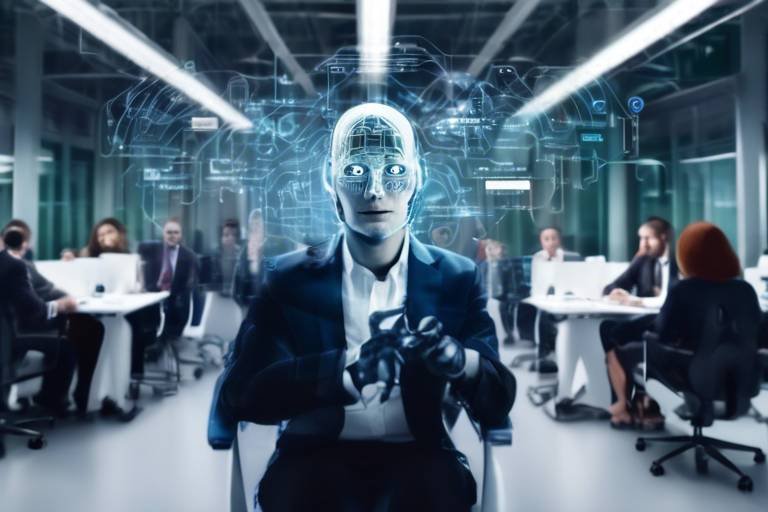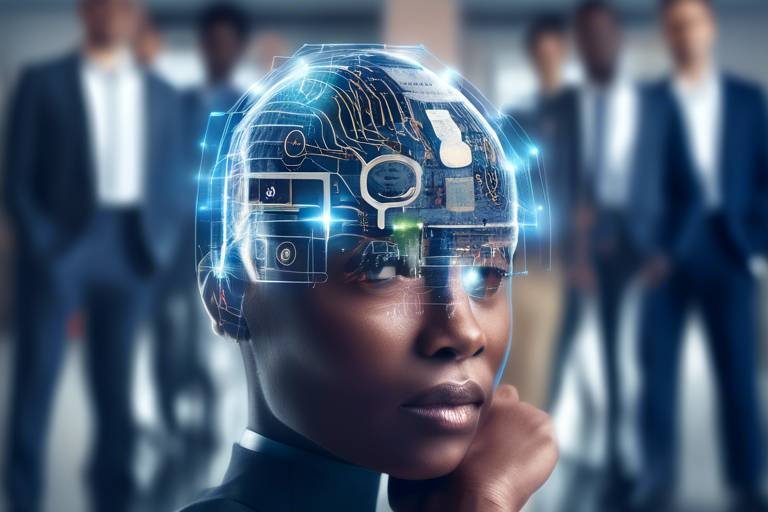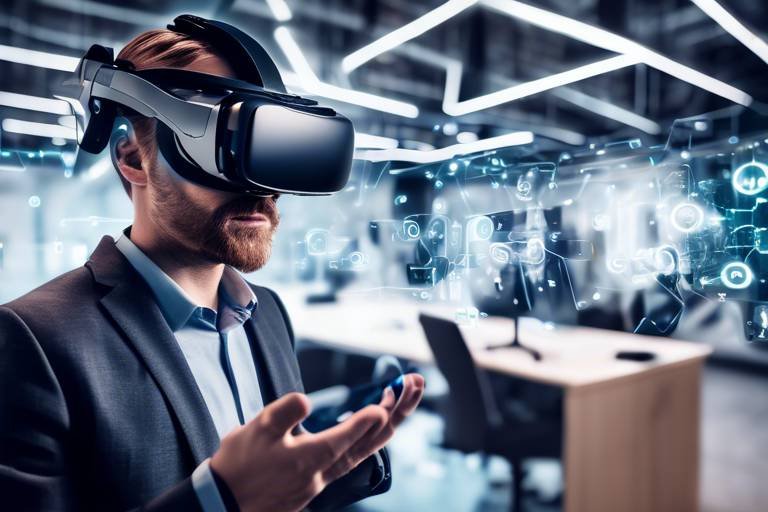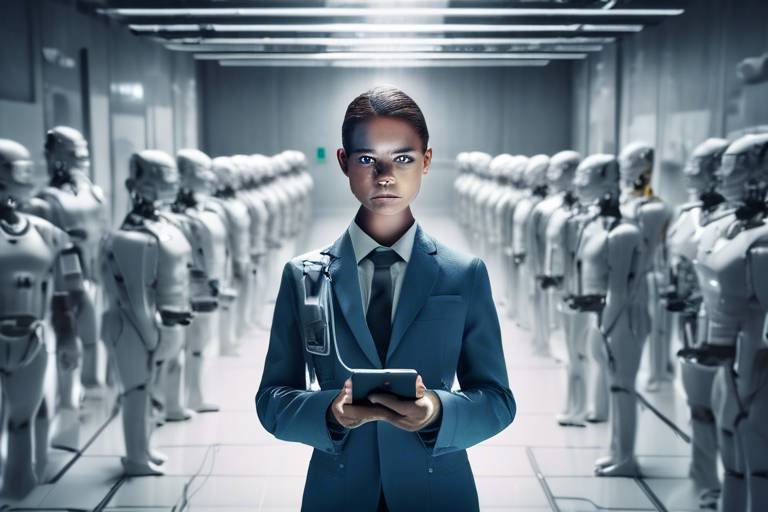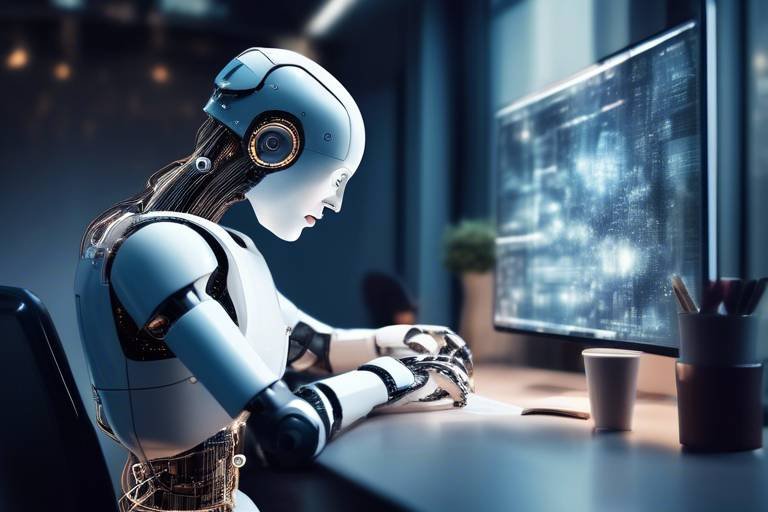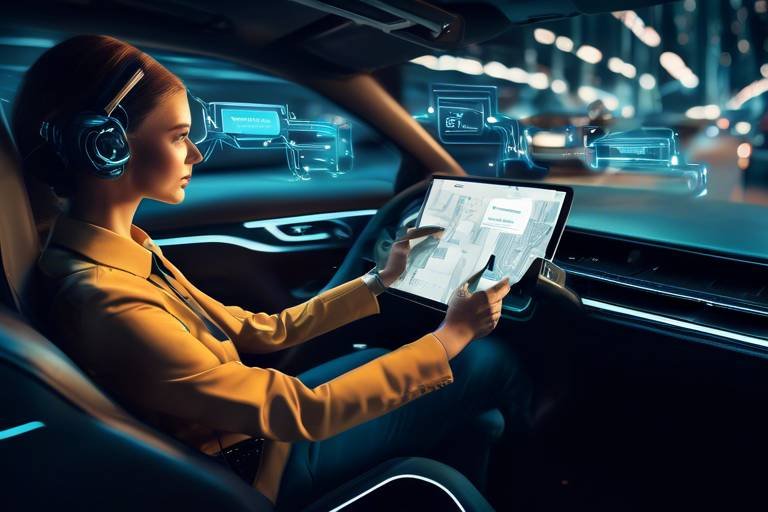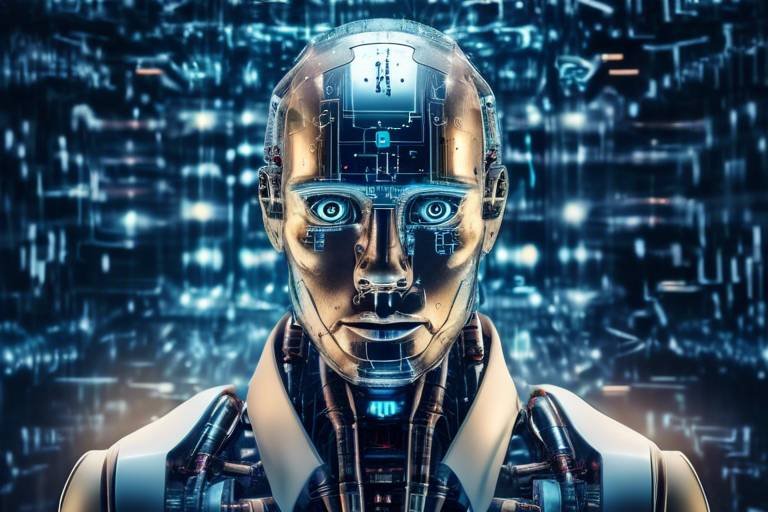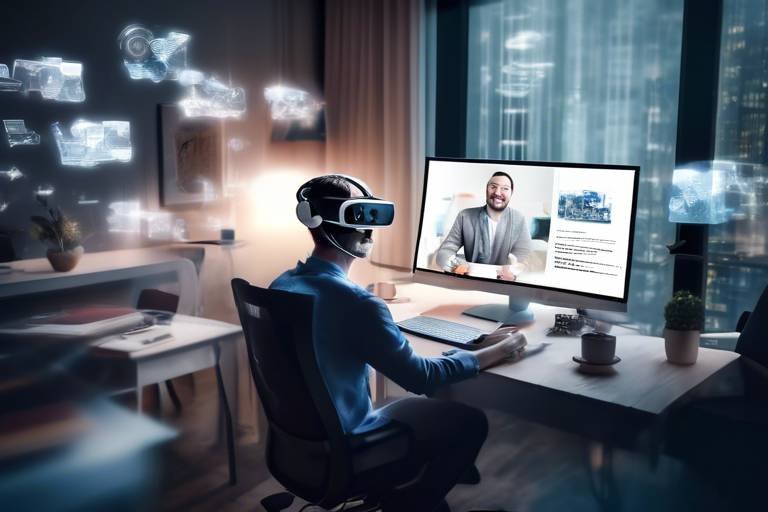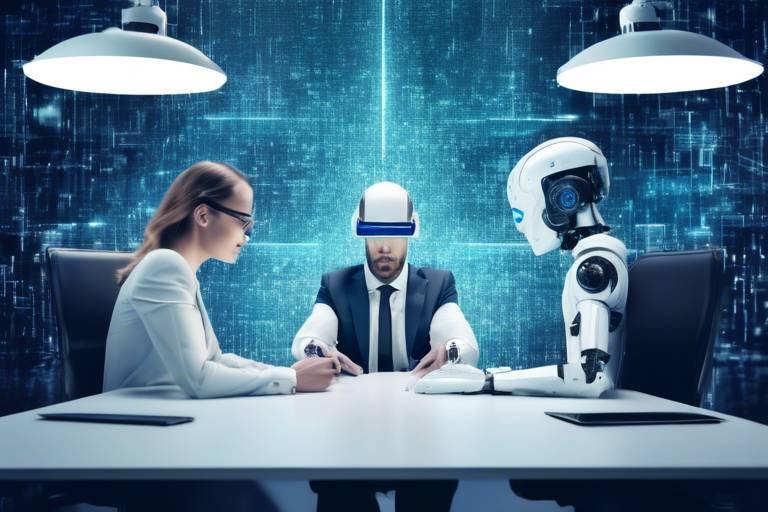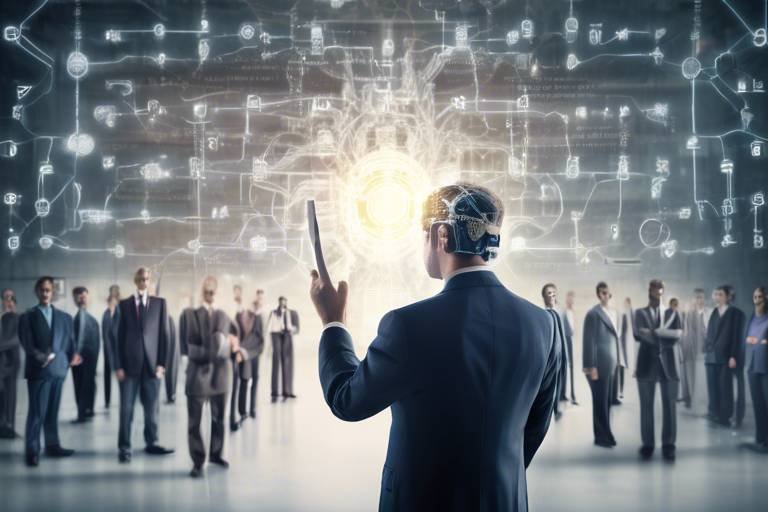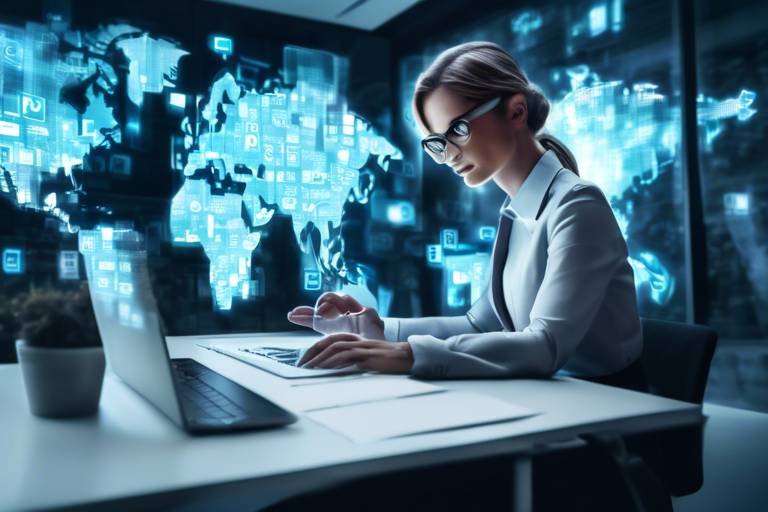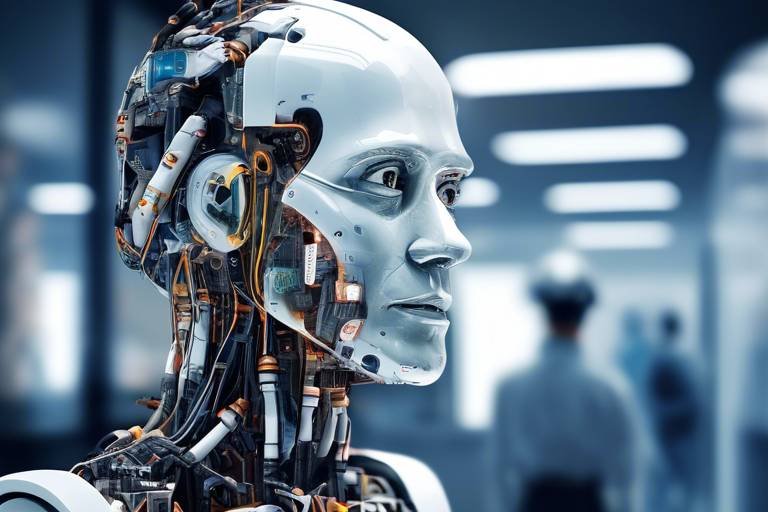Assessing the 'Human' in the AI Dominated Future of Work
As we stand on the brink of a new era defined by artificial intelligence (AI), the question arises: what does it mean to be human in a world increasingly dominated by machines? The workplace is transforming at lightning speed, with AI technologies infiltrating various sectors, reshaping how we work, communicate, and collaborate. While some may perceive this shift as a threat to human jobs, it’s essential to recognize the unique attributes that humans bring to the table—attributes that machines simply cannot replicate.
In this article, we will explore the evolving role of humans in an AI-dominated workplace, focusing on the importance of human skills, adaptability, and emotional intelligence. As AI continues to advance, understanding how to navigate this new landscape is crucial for both employees and employers. So, let’s dive into the heart of the matter: how can we ensure that the human element remains vital in the future of work?
AI technologies are not just a passing trend; they are revolutionizing industries from healthcare to finance, manufacturing to marketing. With the ability to analyze vast amounts of data, automate repetitive tasks, and even predict consumer behavior, AI offers numerous benefits. Companies can enhance productivity, reduce operational costs, and make data-driven decisions faster than ever before. However, this transformation comes with its own set of challenges.
Employees are faced with adapting to new tools and processes that can sometimes feel overwhelming. The fear of being replaced by machines is palpable, and many workers find themselves questioning their place in this new world. It's vital to address these concerns head-on, emphasizing that while AI can handle many tasks, it is the human touch that will always be irreplaceable.
In a technology-driven environment, certain human skills stand out as invaluable. Skills such as creativity, critical thinking, and emotional intelligence are essential in a world where machines excel at processing information but struggle with nuanced understanding. These human attributes complement AI capabilities, creating a powerful synergy that can drive innovation and foster a more dynamic workplace.
Consider creativity as the spark that ignites change. While AI can analyze data and generate reports, it lacks the ability to think outside the box. For instance, in advertising, a human marketer can craft a campaign that resonates emotionally with consumers, drawing on cultural nuances and personal experiences that a machine simply cannot comprehend. This is where human ingenuity truly outshines machine efficiency.
Let’s take a look at some real-world examples where human creativity has led to innovative solutions that AI alone could not achieve. One notable case is the development of the iconic “Share a Coke” campaign by Coca-Cola. This campaign, which personalized bottles with popular names, was a stroke of genius that leveraged human understanding of social connection and personalization—something AI could not have conceived on its own.
Organizations looking to thrive in an AI-dominated landscape must nurture a culture of creativity among their employees. This can be achieved through:
- Encouraging open brainstorming sessions
- Providing resources for professional development
- Creating an environment where failure is seen as a stepping stone to success
By fostering creativity, companies ensure that human input remains a driving force alongside AI technologies, leading to innovative solutions that machines alone cannot provide.
Another area where humans excel is in emotional intelligence. In managing teams and building customer relationships, emotional intelligence is crucial. While AI can analyze data and provide insights, it lacks the ability to empathize and understand the emotional nuances of human interactions. This is where humans shine, as they can navigate complex social dynamics, providing the warmth and understanding that machines simply cannot.
As AI continues to evolve, adaptability becomes a necessary skill for workers. The ability to learn, unlearn, and relearn is essential for remaining relevant in a rapidly changing environment. Workers who embrace change and seek to develop their skills will thrive, while those who resist may find themselves left behind.
Continuous learning and upskilling are vital in the face of technological advancements. Organizations should encourage employees to pursue professional development opportunities, whether through formal education, online courses, or on-the-job training. A proactive approach to career development will empower employees to navigate the shifting landscape with confidence.
Finally, finding the right balance between human and AI collaboration is crucial. Companies need to implement strategies that effectively integrate AI into the workplace while valuing human contributions. This can foster a collaborative environment where both parties work together to achieve common goals, ensuring that the unique strengths of each are leveraged.
- Will AI replace human jobs? While AI may automate certain tasks, it will also create new roles that require human skills, such as creativity and emotional intelligence.
- How can I improve my adaptability skills? Embrace continuous learning, seek feedback, and stay open to new experiences to enhance your adaptability.
- What are some ways to foster creativity in the workplace? Encourage open dialogue, provide resources for development, and create a safe space for experimentation.

The Rise of AI in the Workplace
The workplace is undergoing a seismic shift, and at the heart of this transformation is artificial intelligence (AI). From automating mundane tasks to enhancing decision-making processes, AI technologies are revolutionizing how we work across various industries. But what does this mean for employees? Are we on the brink of a future where machines do all the heavy lifting, leaving humans in the dust? Not quite! While AI is indeed a powerful tool, it also presents unique challenges and opportunities for workers.
Let's take a closer look at how AI is transforming the workplace landscape. For starters, it's important to recognize the benefits that AI brings to the table. Companies are leveraging AI to:
- Increase Efficiency: AI can process vast amounts of data faster than any human, allowing businesses to streamline operations and reduce costs.
- Enhance Decision-Making: With predictive analytics, AI can provide insights that help managers make informed decisions.
- Improve Customer Experience: Chatbots and AI-driven customer service tools offer quick responses and personalized interactions, enhancing customer satisfaction.
However, this rapid adoption of AI isn't without its hurdles. Employees often find themselves grappling with new tools and processes that require a steep learning curve. Imagine walking into your office one day, only to discover that your usual tasks have been taken over by a sophisticated AI system. It can be daunting, right? Many workers fear job displacement as machines take over roles traditionally held by humans. This fear is compounded by the speed at which AI technologies are evolving, leaving many feeling unprepared for the future.
Despite these challenges, the integration of AI into the workplace also opens up a world of possibilities. Workers are encouraged to adapt and evolve alongside these technologies. By embracing AI, employees can focus on more strategic and creative aspects of their jobs, ultimately leading to greater job satisfaction. For instance, instead of spending hours on data entry, a marketing professional can now devote time to crafting innovative campaigns that resonate with customers.
In summary, while the rise of AI in the workplace presents undeniable benefits, it also requires a shift in mindset and skill sets for employees. The key to thriving in this new environment lies in adaptability and a willingness to embrace change. As we navigate this AI-dominated future, it’s crucial to remember that humans still hold a unique place in the workforce—one that machines simply cannot replicate.
Q: Will AI replace all jobs in the future?
A: While AI will automate certain tasks, it is unlikely to replace all jobs. Many roles will evolve, requiring human skills that AI cannot replicate, such as creativity and emotional intelligence.
Q: How can employees prepare for an AI-driven workplace?
A: Continuous learning and upskilling are essential. Employees should focus on developing skills that complement AI technologies and enhance their unique human capabilities.
Q: What role will creativity play in an AI-dominated workplace?
A: Creativity will remain a vital skill as it drives innovation and problem-solving. While AI can assist in data analysis, the human touch in creativity will be irreplaceable.

Human Skills in an AI World
In a world increasingly dominated by artificial intelligence, the question arises: what makes us uniquely human? As AI technologies advance at breakneck speed, it’s crucial to recognize that certain skills are irreplaceable and will continue to hold significant value in the workplace. While machines can process data faster than a speeding bullet, they lack the essence of human creativity, emotional intelligence, and critical thinking. These skills are not just nice-to-haves; they are the bedrock of successful collaboration and innovation in an AI-driven environment.
First and foremost, let’s talk about creativity. It’s the spark that ignites ideas and solutions that machines simply cannot replicate. Imagine a marketing team brainstorming a campaign: while AI can analyze data and suggest trends, it can't come up with the quirky, out-of-the-box ideas that resonate on a human level. This is where human ingenuity shines. The interplay between creativity and automation is fascinating; it’s like a dance where humans lead with their imaginative flair while AI follows, enhancing the execution with data-driven insights.
In this dance of creativity and automation, the importance of human input cannot be overstated. Consider the world of art. An AI can generate stunning visuals, but it lacks the emotional depth and backstory that a human artist pours into their work. This is akin to a chef following a recipe versus a home cook who adds a pinch of love and a dash of personality to their dish. The result? A meal that not only satisfies hunger but also warms the soul. In the workplace, fostering creativity means encouraging teams to take risks and explore new ideas, knowing that even if they fail, they are contributing to a culture of innovation.
Real-world examples abound where human creativity has triumphed over pure automation. Take, for instance, the case of a tech startup that faced a major hurdle in user engagement. Instead of relying solely on AI analytics, the team gathered for a brainstorming session. They synthesized user feedback, shared personal experiences, and ultimately devised a campaign that resonated deeply with their audience. The result? A 50% increase in engagement, showcasing how human creativity complemented AI capabilities rather than being overshadowed by them.
Organizations looking to nurture a culture of creativity among employees should consider implementing strategies that promote collaboration and open dialogue. Here are a few key approaches:
- Encourage Experimentation: Create a safe space for employees to test out new ideas without the fear of failure.
- Provide Resources: Invest in tools and training that help employees enhance their creative skills.
- Celebrate Innovation: Recognize and reward creative contributions to motivate others.
By fostering such an environment, organizations can ensure that human input remains a driving force alongside AI technologies.
Another critical human skill that stands tall in an AI-dominated world is emotional intelligence. While AI can analyze patterns and predict behaviors, it cannot understand the nuances of human emotions. This is particularly important in managing teams and building customer relationships. Humans excel in areas where empathy and understanding are required, such as resolving conflicts, motivating team members, or providing exceptional customer service. The ability to connect on an emotional level can make all the difference in creating loyal customers and cohesive teams.
In conclusion, as we navigate through this AI-dominated landscape, it’s clear that human skills will not only coexist with technology but will also enhance its capabilities. The future of work is not about replacing humans with machines; it’s about leveraging the best of both worlds. By honing our unique human skills—creativity, emotional intelligence, and adaptability—we can ensure that we remain relevant and indispensable in the evolving workplace.
Q: Will AI completely replace human jobs?
A: While AI will automate certain tasks, it will also create new roles that require human skills, particularly in creativity and emotional intelligence.
Q: How can I improve my emotional intelligence?
A: You can enhance your emotional intelligence by practicing active listening, being aware of your own emotions, and seeking feedback from others.
Q: What are some ways to foster creativity in the workplace?
A: Encourage brainstorming sessions, provide opportunities for professional development, and create a culture that celebrates innovative thinking.

Creativity vs. Automation
In today's fast-paced world, the clash between creativity and automation has become a hot topic of discussion. On one hand, we have machines and algorithms that can churn out data at lightning speed, performing tasks with precision and efficiency. On the other hand, we have the inherent human ability to think outside the box, to dream, and to innovate. So, where does that leave us? Are we destined to be overshadowed by machines, or do we still hold the key to creativity that no algorithm can replicate?
To put it simply, while automation can handle repetitive tasks and analyze vast amounts of information, it lacks the imagination and emotional depth that define human creativity. Imagine a world where every product is designed by a machine—sure, they might be efficient, but would they resonate with people? Would they tell a story? This is where the magic of human creativity shines through. It’s the spark that ignites innovation, leading to breakthroughs that machines simply cannot conceive.
Consider the realm of advertising, for instance. Automated tools can analyze trends and generate reports, but they can't create a compelling narrative that captures the essence of a brand or connects with an audience on an emotional level. This is why creative professionals are still in high demand, even as AI continues to evolve. They bring a unique perspective that machines lack, and this is crucial in crafting messages that resonate with consumers.
Furthermore, creativity often thrives in environments where collaboration and diversity of thought are encouraged. In contrast, automation tends to streamline processes, which can sometimes stifle the very creativity it aims to enhance. A creative team brainstorming new ideas is like a jazz band, where each player contributes their unique sound to create something beautiful. In this scenario, automation is more like a metronome—keeping time but lacking the ability to improvise.
In essence, the relationship between creativity and automation isn't one of competition but rather complementarity. While machines can handle the mundane, humans can focus on what truly matters: the big ideas, the innovative solutions, and the emotional connections that drive businesses forward. To thrive in an AI-dominated workplace, organizations must recognize the importance of fostering creativity alongside automation, ensuring that both elements work in harmony.
As we navigate this new landscape, it’s crucial for companies to invest in nurturing a culture of creativity. This could involve providing employees with opportunities to engage in creative projects, encouraging cross-departmental collaboration, or even hosting workshops that stimulate innovative thinking. By doing so, businesses can leverage the strengths of both humans and machines, creating a workplace that is not only efficient but also vibrant and dynamic.
Ultimately, the future belongs to those who can blend the analytical prowess of AI with the imaginative capabilities of humans. This synergy will not only drive innovation but also ensure that we remain relevant in a world increasingly dominated by technology. So, the next time you hear about automation, remember: it’s not about replacing creativity; it’s about enhancing it.
- Can AI replace human creativity? No, while AI can assist in creative processes, it cannot replicate the emotional and imaginative aspects of human creativity.
- How can organizations foster creativity in an automated world? Companies can encourage creativity by promoting collaboration, providing creative project opportunities, and investing in training and workshops.
- What is the role of emotional intelligence in creativity? Emotional intelligence enhances creativity by enabling individuals to understand and connect with others, leading to more innovative ideas and solutions.

Case Studies of Creative Problem Solving
In today's rapidly evolving workplace, the need for creative problem solving has never been more critical. While artificial intelligence can crunch numbers and analyze data at lightning speed, it often falls short in scenarios that require a touch of human ingenuity. Let’s delve into some fascinating case studies that illustrate how human creativity has triumphed over mere automation.
One standout example comes from the world of advertising. Consider the iconic "Share a Coke" campaign launched by Coca-Cola. The company faced declining sales and needed a fresh approach to connect with younger consumers. Instead of relying solely on data-driven marketing strategies, the team tapped into the emotional connection people have with names. By personalizing Coke bottles with popular names, they created a buzz that resonated deeply with consumers, leading to a significant sales increase. This campaign exemplifies how creative thinking can unlock solutions that data alone might overlook.
Another compelling case is from the healthcare sector. During the COVID-19 pandemic, hospitals were overwhelmed, and the demand for testing skyrocketed. A team of healthcare professionals and engineers came together to create a rapid testing solution. They brainstormed and designed a testing kit that could deliver results in under an hour, significantly faster than existing methods. This innovation not only showcased their technical skills but also highlighted the importance of teamwork and creative problem-solving in addressing urgent challenges.
In the realm of technology, let's look at how Airbnb transformed the way people book accommodations. Faced with intense competition and a saturated market, the founders realized that they needed to stand out. They decided to focus on the unique experiences their hosts could offer, rather than just the properties themselves. By encouraging hosts to share local insights and create personalized experiences, Airbnb shifted its marketing strategy from a transactional platform to a community-driven service. This creative pivot not only set them apart but also fostered a loyal customer base.
These case studies highlight a crucial point: while AI can assist in many areas, it is the human element—our ability to think outside the box and empathize with others—that truly drives innovation. As we move forward in an AI-dominated landscape, fostering a culture that encourages creativity will be vital. Organizations must not only leverage AI tools but also empower their teams to think creatively and collaboratively, ensuring that human input remains a key ingredient in problem-solving.
In conclusion, the blend of human creativity and AI capabilities can lead to groundbreaking solutions that neither could achieve alone. By embracing this synergy, we can navigate the complexities of the modern workplace and continue to innovate in ways that resonate with people.
- What is creative problem solving? Creative problem solving refers to the ability to think differently and find innovative solutions to challenges, often requiring out-of-the-box thinking.
- How does AI impact creativity in the workplace? While AI can automate routine tasks, it lacks the emotional intelligence and unique perspective that humans bring, making human creativity essential in many scenarios.
- Can organizations foster creativity among employees? Yes, organizations can encourage creativity by creating an open environment, promoting collaboration, and providing resources for skill development.

Fostering a Creative Culture
In today's rapidly evolving work environment, where artificial intelligence is becoming a cornerstone of operational efficiency, fostering a creative culture within organizations is more crucial than ever. But what does it truly mean to cultivate creativity in a workplace dominated by algorithms and automation? It’s about creating an atmosphere where innovation thrives and employees feel empowered to express their ideas freely. Companies that prioritize creativity not only enhance employee satisfaction but also drive better business outcomes. After all, when people feel valued and inspired, they produce their best work.
To effectively nurture a creative culture, organizations need to implement several key strategies. First and foremost, they should encourage open communication. This means establishing channels where employees can share ideas without fear of criticism. Imagine a brainstorming session where every voice is heard, and every idea is considered, no matter how outlandish it might seem. This kind of environment can lead to unexpected breakthroughs and innovative solutions that might not have surfaced in a more rigid setting.
Next, it’s essential to provide opportunities for collaboration. When diverse teams come together, they bring a wealth of perspectives that can spark creativity. For instance, pairing tech-savvy employees with those who excel in creative thinking can lead to unique projects that blend functionality with artistic flair. Companies can facilitate this by organizing cross-departmental workshops or innovation labs where teams can collaborate on projects outside of their usual scope of work.
Moreover, organizations should recognize and celebrate creativity. This can be as simple as acknowledging innovative ideas in team meetings or as elaborate as hosting an annual awards event dedicated to creative achievements. When employees see that their creative efforts are valued, it motivates them to continue thinking outside the box. To further support this, companies can establish a dedicated budget for creative initiatives, allowing teams to experiment and explore new ideas without the constraints of traditional funding processes.
Lastly, leadership plays a pivotal role in fostering a creative culture. Leaders should model creative behavior themselves, demonstrating that taking risks and thinking differently is not only accepted but encouraged. They can also provide mentorship and support for employees who wish to pursue creative endeavors, whether that’s through training programs, workshops, or simply offering time away from regular duties to focus on innovation. By cultivating an environment that prioritizes creativity, organizations can ensure that human ingenuity remains a vital component of their success, even in an AI-driven landscape.
- Why is creativity important in the workplace? Creativity fosters innovation, improves problem-solving, and enhances employee satisfaction.
- How can I encourage creativity among my team? Promote open communication, collaboration, and recognition of creative efforts.
- What role does leadership play in fostering a creative culture? Leaders should model creative behavior and support their team's creative initiatives.
- Can AI contribute to creativity in the workplace? Yes, AI can assist in generating ideas, but human creativity is essential for innovation.

Emotional Intelligence and AI
In a world where artificial intelligence is making strides in efficiency and productivity, one might wonder: what role does emotional intelligence (EI) play in this increasingly automated landscape? While AI can process data and analyze patterns at lightning speed, it falls short in areas that require a deep understanding of human emotions, social nuances, and interpersonal relationships. This is where the human touch becomes invaluable. Emotional intelligence encompasses the ability to recognize and manage our own emotions, as well as the emotions of others. It's about empathy, communication, and connection—qualities that machines simply cannot replicate.
The significance of emotional intelligence in the workplace cannot be overstated. For instance, consider a customer service scenario where a client is upset due to a service failure. An AI might provide a generic response based on data, but it takes a human with high emotional intelligence to genuinely understand the customer's feelings, offer empathy, and craft a solution that feels personal and sincere. This human connection can turn a negative experience into a positive one, fostering customer loyalty and trust.
Moreover, emotional intelligence plays a crucial role in team dynamics. In collaborative environments, understanding team members' emotions can lead to better communication and conflict resolution. A leader who is emotionally intelligent can sense when team morale is low and take proactive steps to boost motivation, creativity, and productivity. In contrast, an AI, while it can analyze performance metrics, lacks the ability to intuitively grasp the emotional climate of a team.
As organizations increasingly implement AI tools, it's essential to recognize that these technologies should complement, not replace, human interactions. The most successful workplaces will be those that blend AI's strengths with the irreplaceable human qualities of empathy and understanding. Companies that prioritize emotional intelligence in their culture will find themselves better equipped to navigate the complexities of the modern workplace.
To further illustrate the importance of emotional intelligence in the age of AI, let's look at a few key areas where humans excel:
- Empathy: The ability to understand and share the feelings of others is crucial in building relationships, whether with colleagues or customers.
- Conflict Resolution: Navigating disagreements requires a nuanced understanding of emotions and the ability to mediate effectively.
- Leadership: Inspiring and motivating a team is a deeply human skill that relies on emotional intelligence to connect with individuals on a personal level.
In conclusion, while AI continues to advance and take over routine tasks, it is the human ability to connect emotionally that will set us apart. As we move forward, embracing emotional intelligence will not only enhance workplace relationships but also ensure that we remain relevant in an AI-driven future.
Q: What is emotional intelligence?
A: Emotional intelligence is the ability to recognize, understand, and manage our own emotions as well as the emotions of others. It involves skills such as empathy, communication, and emotional regulation.
Q: How does emotional intelligence benefit the workplace?
A: High emotional intelligence can lead to improved communication, better teamwork, effective conflict resolution, and enhanced leadership, all of which contribute to a more positive work environment.
Q: Can emotional intelligence be developed?
A: Yes, emotional intelligence can be cultivated through self-awareness, practice, and feedback. Training programs and workshops can also help individuals enhance their emotional intelligence skills.
Q: How does AI affect emotional intelligence in the workplace?
A: AI can handle data-driven tasks but lacks the ability to understand and respond to human emotions. Therefore, emotional intelligence remains a critical skill for employees, especially in roles that require interpersonal interactions.

The Importance of Adaptability
In today's fast-paced world, where change is the only constant, the ability to adapt has become a crucial skill for success. As artificial intelligence (AI) technologies continue to evolve and reshape the workplace, workers must embrace adaptability to remain relevant and thrive. Imagine a chameleon; it changes its colors to blend into its surroundings. Similarly, adaptability allows individuals to adjust their skills and approaches in response to new challenges and opportunities. This flexibility is not just about keeping up with technology; it's about anticipating changes and proactively adjusting to them.
One of the most significant aspects of adaptability is the willingness to learn. With AI automating routine tasks, employees are often required to take on more complex responsibilities that demand critical thinking and creativity. This shift calls for a mindset that prioritizes continuous learning and upskilling. In fact, according to a recent study, 85% of jobs that will exist in 2030 have not yet been invented, meaning that the skills needed in the future are still unknown. This uncertainty highlights the importance of being adaptable. Workers who cultivate a habit of learning new skills will not only survive but also thrive in this unpredictable landscape.
Adapting to change also involves emotional resilience. As organizations integrate more AI tools, employees may experience feelings of insecurity or fear about their job stability. Building emotional resilience helps individuals cope with these feelings, allowing them to embrace change rather than resist it. Furthermore, fostering a culture of adaptability within organizations can lead to increased employee engagement and satisfaction. When employees feel supported in their efforts to adapt, they are more likely to contribute positively to the workplace environment.
To illustrate the significance of adaptability, consider the following table that outlines the key benefits of being adaptable in the workplace:
| Benefit | Description |
|---|---|
| Enhanced Problem-Solving | Adaptable individuals can approach challenges from multiple angles, leading to innovative solutions. |
| Increased Job Security | Those who can learn and adjust are less likely to be replaced by automation. |
| Improved Collaboration | Adaptable team members foster a culture of openness, making collaboration more effective. |
| Greater Resilience | Adaptability builds resilience, allowing individuals to bounce back from setbacks more effectively. |
In conclusion, the importance of adaptability in the AI-dominated future cannot be overstated. As workers, we must cultivate a mindset that embraces change, prioritizes continuous learning, and fosters emotional resilience. Organizations, too, play a vital role in nurturing this adaptability by providing resources and support for their employees. The future belongs to those who can pivot, adjust, and innovate in the face of uncertainty. So, are you ready to become that adaptable chameleon in your career?
- Why is adaptability important in the workplace? Adaptability is essential as it enables employees to respond effectively to changes, ensuring they remain relevant and capable of meeting new challenges.
- How can I improve my adaptability skills? You can improve adaptability by embracing continuous learning, seeking feedback, and practicing emotional resilience.
- What role do organizations play in fostering adaptability? Organizations can support adaptability by providing training, resources, and a culture that encourages innovation and flexibility.

Learning and Upskilling
In today’s fast-paced world, where technology is evolving at lightning speed, the importance of learning and upskilling cannot be overstated. As artificial intelligence continues to reshape the workplace, employees find themselves at a crossroads: adapt or become obsolete. But what does this mean for the average worker? Simply put, it’s a call to action to embrace lifelong learning. The truth is, the skills that were once considered sufficient may no longer hold up in the face of automation and AI advancements.
Imagine a world where your job is constantly changing, where new tools and technologies emerge almost overnight. It’s like trying to catch a train that’s always moving—if you don’t keep up, you might just miss it! This is why developing a mindset geared towards continuous learning is crucial. Upskilling isn’t just about picking up new technical skills; it’s about nurturing a growth mindset that allows you to adapt to any situation. Whether it’s learning how to work alongside AI tools or enhancing your soft skills, the key is to stay relevant.
Furthermore, organizations play a vital role in this journey. They need to foster an environment that encourages employees to pursue ongoing education. This could be through workshops, online courses, or even mentorship programs. By investing in their workforce, companies not only enhance their productivity but also cultivate a culture of innovation and resilience. After all, a team that learns together grows together. Here are some effective strategies organizations can implement:
- Encourage a Learning Culture: Promote an environment where employees feel comfortable asking questions and seeking knowledge.
- Provide Resources: Offer access to online courses, webinars, and industry conferences to keep employees informed about the latest trends.
- Implement Mentorship Programs: Pairing less experienced employees with seasoned professionals can facilitate knowledge sharing and skill development.
Moreover, individuals should take charge of their own learning paths. This means identifying gaps in their skill sets and actively seeking opportunities to fill those gaps. For instance, if you’re a marketing professional, understanding data analytics can significantly boost your value in the workplace. The more versatile your skill set, the more indispensable you become. Think of yourself as a Swiss Army knife—equipped with various tools that can tackle any challenge thrown your way!
In conclusion, learning and upskilling are not just buzzwords; they are essential strategies for thriving in an AI-dominated future. By embracing continuous education, both employees and organizations can ensure they remain competitive and successful in an ever-changing landscape. Remember, the future belongs to those who are willing to learn and adapt!
- What is the best way to start upskilling? Begin by assessing your current skills and identifying areas for improvement. Look for online courses or local workshops that cater to those needs.
- How often should I update my skills? Regularly! Aim to learn something new every few months to stay ahead in your field.
- Are there free resources available for learning? Yes! Many platforms, such as Coursera, edX, and Khan Academy, offer free courses on a variety of subjects.
- How can my employer support my learning journey? Employers can provide resources, time for training, and opportunities for professional development.

Balancing Human and AI Collaboration
In today's rapidly evolving workplace, finding the right balance between human and AI collaboration is not just a goal—it's a necessity. As artificial intelligence systems become more integrated into our daily tasks, it's crucial to ensure that these technologies complement human abilities rather than replace them. So, how can organizations achieve this delicate balance?
First and foremost, companies need to foster an environment where both AI and human contributions are valued. This means recognizing that while AI can process vast amounts of data and perform repetitive tasks with precision, it lacks the nuances of human judgment and creativity. To illustrate this point, consider a scenario where a marketing team uses AI tools for data analysis. The AI can identify trends and generate reports, but it’s the human team members who can interpret these findings, infuse them with creative insights, and develop innovative marketing strategies. This partnership allows for a more holistic approach to problem-solving.
Furthermore, organizations should invest in training programs that equip employees with the skills to work alongside AI effectively. This could involve workshops that focus on understanding AI capabilities and limitations, as well as developing skills that AI cannot replicate, such as emotional intelligence and creative thinking. By empowering employees to embrace AI tools, companies can enhance productivity while ensuring that human intuition and empathy remain at the forefront of decision-making processes.
Another critical aspect of balancing human and AI collaboration is open communication. Employees should feel comfortable discussing how AI impacts their work and provide feedback on AI systems. Regular meetings and brainstorming sessions can help bridge the gap between human creativity and AI efficiency. For instance, a tech company might hold monthly innovation labs where employees can share their experiences with AI tools, suggest improvements, and collaborate on new ideas. This not only enhances the relationship between humans and AI but also fosters a culture of continuous improvement.
Moreover, organizations can implement a hybrid model of work where AI handles routine tasks, allowing human workers to focus on more complex and creative challenges. This model not only boosts efficiency but also increases job satisfaction, as employees can engage in work that is more fulfilling and aligned with their skills. A study from the World Economic Forum indicated that jobs requiring a combination of human and AI collaboration are projected to grow significantly, highlighting the importance of adapting to this new work dynamic.
In summary, balancing human and AI collaboration is about creating a synergy where both can thrive. By investing in training, fostering open communication, and implementing hybrid work models, organizations can ensure that their workforce remains relevant and engaged. As we navigate this AI-dominated future, it’s essential to remember that while technology can enhance our capabilities, it’s the human touch that truly drives innovation and success.
- What are the key benefits of balancing human and AI collaboration?
Balancing human and AI collaboration leads to increased productivity, enhanced creativity, and improved job satisfaction, as employees can focus on more complex tasks while AI handles routine work. - How can organizations train employees to work with AI?
Organizations can provide workshops that cover AI capabilities, limitations, and skills that AI cannot replicate, such as emotional intelligence and creative problem-solving. - What role does communication play in human-AI collaboration?
Open communication allows employees to express their experiences and feedback regarding AI systems, fostering a culture of continuous improvement and collaboration. - What is a hybrid work model?
A hybrid work model is one where AI manages routine tasks, freeing up human workers to tackle more complex and creative challenges, enhancing both efficiency and job satisfaction.
Frequently Asked Questions
- What impact is AI having on the workplace?
AI is transforming the workplace by automating repetitive tasks, enhancing productivity, and providing data-driven insights. However, it also presents challenges as employees must adapt to new tools and processes, which can lead to job displacement in some sectors.
- Why are human skills still important in an AI-driven world?
Human skills such as creativity, critical thinking, and emotional intelligence are irreplaceable. While AI excels at data processing and automation, it lacks the ability to understand context, emotions, and complex problem-solving that humans naturally possess.
- How can creativity coexist with automation?
Creativity and automation can complement each other. While AI can handle mundane tasks, humans can focus on innovative thinking and creative solutions. This partnership allows organizations to leverage the strengths of both AI and human ingenuity.
- Can you provide examples of human creativity solving problems that AI could not?
Absolutely! Consider the case of a marketing team that used creative brainstorming to develop a unique campaign that resonated emotionally with their audience. While AI can analyze trends, it cannot generate the emotional connection that humans can.
- How can organizations foster a culture of creativity?
Organizations can nurture creativity by encouraging open communication, providing resources for creative projects, and allowing employees the freedom to experiment. Creating a safe space for sharing ideas without judgment can lead to innovative breakthroughs.
- What role does emotional intelligence play in the workplace?
Emotional intelligence is crucial for managing teams and building strong customer relationships. It enables individuals to navigate social complexities, empathize with others, and respond effectively to emotional cues, something AI cannot replicate.
- How can workers develop adaptability skills?
Workers can develop adaptability by embracing continuous learning, seeking feedback, and staying updated on industry trends. Engaging in new experiences and stepping out of comfort zones can also enhance one's ability to adapt to change.
- What are some effective strategies for balancing human and AI collaboration?
To balance human and AI collaboration, organizations should clearly define roles, ensuring that AI supports rather than replaces human effort. Encouraging teamwork and open dialogue about AI's capabilities can also foster a more collaborative environment.

